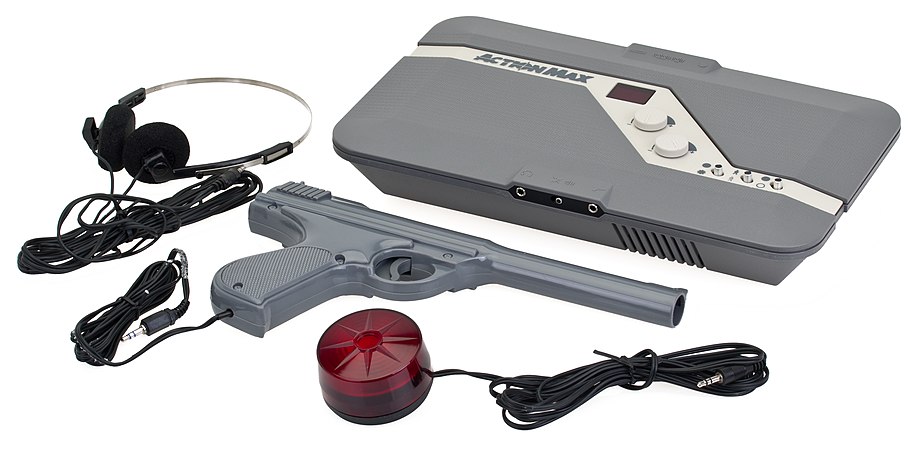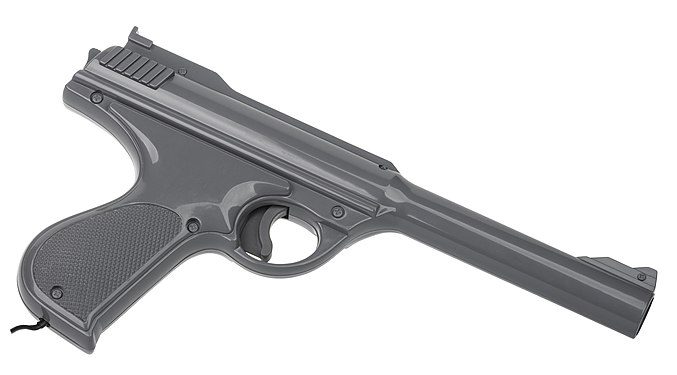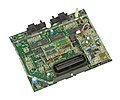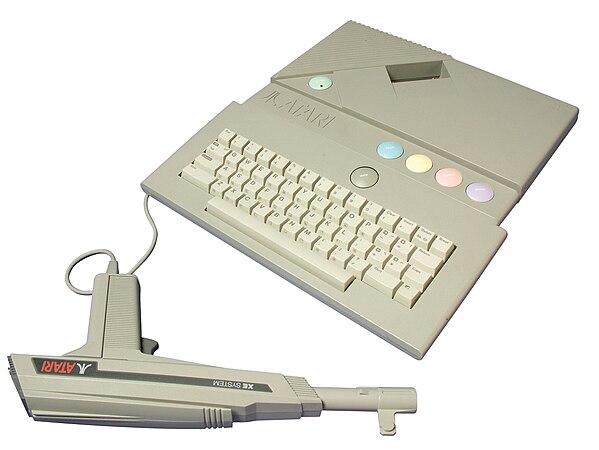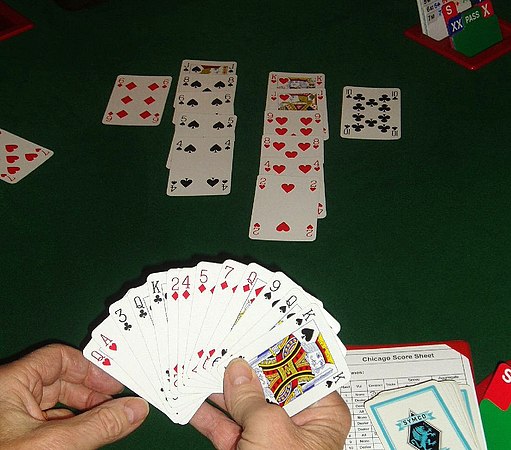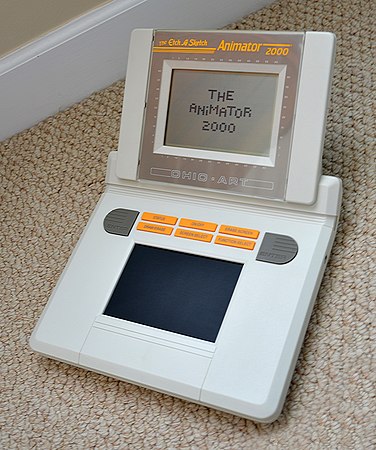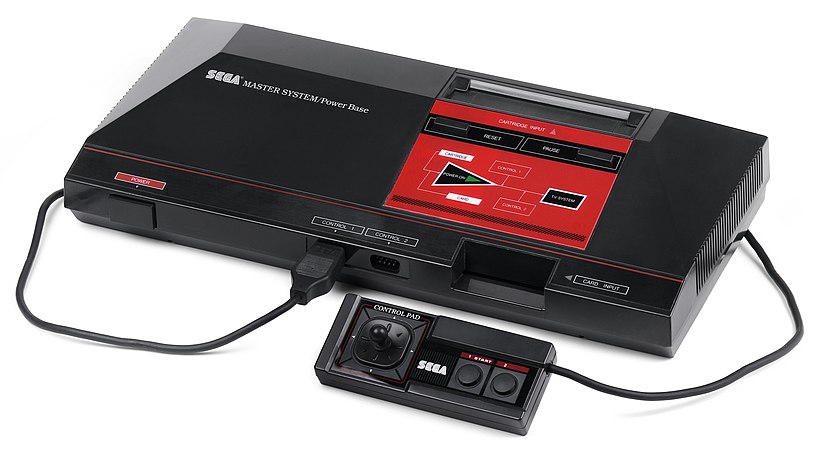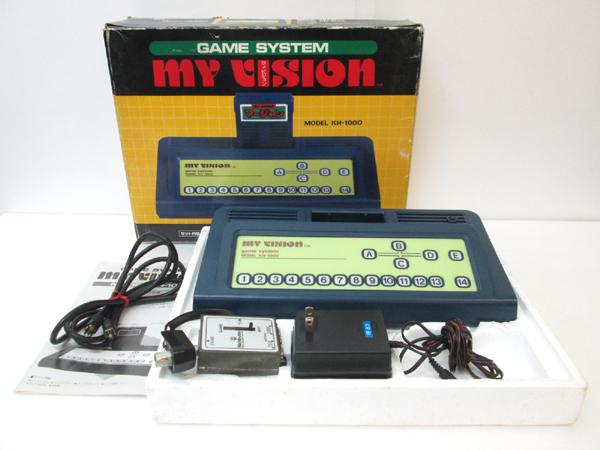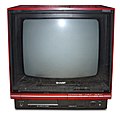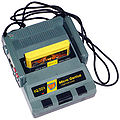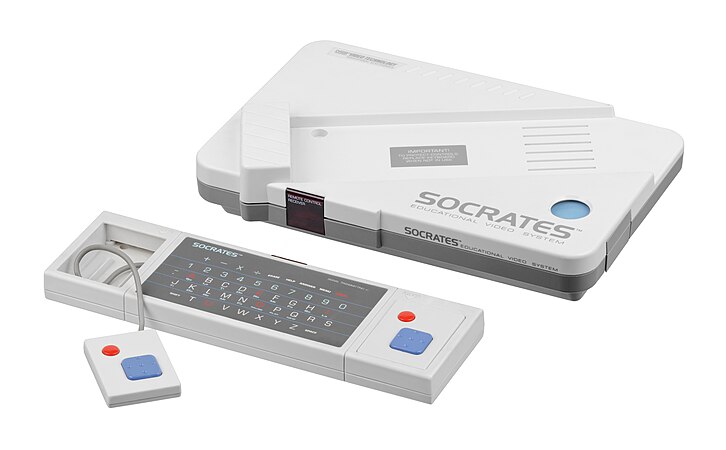History of video games/Print version/Third Generation of Video Game Consoles
| This is the print version of History of video games You won't see this message or any elements not part of the book's content when you print or preview this page. |
- Third generation of video game consoles
Trends
[edit | edit source]Improved hardware
[edit | edit source]By this point home console graphics became more capable, and were able to more easily represent characters and believable locations with colorful 2D graphics. Music began to take a bigger role in home game consoles.While consoles were still limited in their audio capabilities, many classic game soundtracks have their origins in this generation.
By this point, most home consoles contained most of their computer hardware in the console itself rather than in the cartridges, allowing for cheaper cartridges to be made. This freed up resources to either make cheaper cartridges, or to place enhancements in cartridges such as specialty chips that enhanced features such as audio. This generation also saw increased adoption of save game functionality, which was typically achieved with battery backed RAM located on the cartridge. Still, many games required gamers to save their progress by writing down a password which indicated their progress, and then re entering it when loading the game, which was a tedious endeavor.
VHS consoles
[edit | edit source]A few companies attempted to leverage the audio visual capabilities of Video Home System (VHS) analog cassettes to improve the gaming experience, though no VHS consoles saw huge levels of success. By the fourth generation, companies pursing the same strategy would elect for the digital focused CD-ROM drives instead, though it would take till the fifth generation to see successful game consoles capable of full motion video.
References
[edit | edit source]
-
The Action Max system with headphones, light gun, and red light.
History
[edit | edit source]Development
[edit | edit source]The Action Max was developed by Worlds of Wonder, a company founded by former Atari Employees who helped Nintendo distribute the NES in America.[1]
Launch
[edit | edit source]
Worlds of Wonder had a limited launch of the Action Max in 1987.[2] The system was a poor seller due to needing a VCR,[3] and unable to bail out the company from it's massive debts. Worlds of Wonder went bankrupt in 1988, with many employees going on to join Nintendo.[4][1]
Technology
[edit | edit source]The Action Max ran lightgun games off of VHS tapes.[5] A small seven segment display on the unit displayed the player score.[2][6]
Compute
[edit | edit source]The Action Max CPU is an an 8-bit Hitachi HD401010 clocked at 4MHz.[2][4][7] The Action Max has 32 bytes of RAM.[4]
Notable games
[edit | edit source]Five games were released for the Action Max.[4]
- The Rescue of Pops Ghostly
- Blue Thunder - Based on the film
- Hydrosub: 2021
- Sonic Fury - Pack in game
- .38 Ambush Alley
Gallery
[edit | edit source]Console
[edit | edit source]Accessories
[edit | edit source]-
The Action Max gun controller. Note the lack of an orange tip on the barrel or other indicators to clearly indicate that this is not a real firearm.
-
This red light was used to indicate successful hits.
-
Action Max Stereo Headphones.
-
Sonic Fury PAL VHS tape for Action Max.
Internals
[edit | edit source]References
[edit | edit source]| Parts of this page are based on materials from: Wikipedia: the free encyclopedia. |
- ↑ a b "System Overview: System Overview - Worlds of Wonder Action Max - Beyond the Mind's Eye - Thoughts & Insights from Marriott_Guy". www.rfgeneration.com. Retrieved 28 October 2020.
- ↑ a b c "ActionMax - Game Console - Computing History". www.computinghistory.org.uk. Retrieved 26 October 2020.
- ↑ "BIG TROUBLE IN TOYLAND : Debt-Ridden Worlds of Wonder, the Maker of Teddy Ruxpin, Is Looking for Way Out of Woods". Los Angeles Times. 14 December 1987. Retrieved 28 October 2020.
- ↑ a b c d "Home Page". Video Game Console Library. Retrieved 26 October 2020.
- ↑ "Only In The 80's Would They Put Video Games On A VHS Tape" (in en-us). Kotaku. https://kotaku.com/only-in-the-80s-would-they-put-video-games-on-a-vhs-tap-5786220. Retrieved 26 October 2020.
- ↑ "Action Max". thegamesdb.net. Retrieved 3 December 2020.
- ↑ "About - WoW Action Max - Games Database". www.gamesdatabase.org. Retrieved 4 November 2020.
-
An Amstrad GX4000 with Controller.
History
[edit | edit source]Launch
[edit | edit source]Bring the whole arcade into your home.—Tagline for the Amstrad GX4000, The Game Show[1]
The Amstrad GX4000 was launched in 1990 as a console version of the Amstrad CPC series of 8-bit computers that cost $150 at launch.[2] The console was to have a 15 million British pound marketing campaign.[3]
Legacy
[edit | edit source]The console did not sell well, and retailers tried to unload stock by selling the GX4000 as a price as low as $30.[2] The console is often said to have sold about 15,000 units,[4] though some sources give sales figures for the console as high as 150,000 units.[5][6] The Amstrad GX4000 was discontinued in 1991.[4]
Technology
[edit | edit source]
Compute
[edit | edit source]The Amstrad GX4000 used a 8-Bit Z80A CPU clocked at 4MHz.[7] The system was capable of about 0.58 million instructions per second (MIPS).[8]
The GX4000 has 64 kilobytes of RAM and 16 kilobytes of video RAM.[9][10]
Hardware
[edit | edit source]The Amstrad GX4000 uses a General Instrument AY-3-8912 chip for audio.[11] Though General Instrument was once a major supplier of chips in the first consoles, the GX4000 is a notable late use of such chips, owing to it's 1980's computer heritage.
The GX4000 Power Supply is among the most notorious official power supplies in any console,[12] as it's use typically results in the console being destroyed due to it's exceptionally poor quality.
Notable games
[edit | edit source]27 cartridges were produced for the GX4000.[2]
Gallery
[edit | edit source]Amstrad GX4000
[edit | edit source]Controller
[edit | edit source]Internals
[edit | edit source]References
[edit | edit source]- ↑ "Amstrad GX4000 - The Amstrad CPC Games Console". Retrieved 20 May 2021.
- ↑ a b c Rignall, Jaz (3 January 2016). "Consoles You've Never Heard of: Amstrad GX4000" (in en). USgamer. https://www.usgamer.net/articles/gx4000. Retrieved 25 October 2020.
- ↑ Screen Digest. Screen Digest Limited. Retrieved 3 December 2020.
- ↑ a b McFerran, Damien (March 9th, 2017). "6 games console flops that gave gaming a bad name" (in en). TechRadar. https://www.techradar.com/news/6-games-console-flops-that-gave-gaming-a-bad-name. Retrieved 25 October 2020.
- ↑ Civera, David (January 11, 2013). "21 Consoles And Handhelds That Crashed And Burned" (in en). Tom's Hardware. https://www.tomshardware.com/picturestory/611-console-handheld-fail.html.
- ↑ "Info on the Amstrad GX-4000". RetroRGB. 4 November 2019. https://www.retrorgb.com/info-on-the-amstrad-gx-4000.html.
- ↑ "Amstrad GX4000 - Game Console - Computing History". www.computinghistory.org.uk. Retrieved 25 October 2020.
- ↑ Murnane, Kevin. "From Pong To Playstation: The 40-Year Evolution Of Gaming Processing Power". Forbes. Retrieved 26 October 2020.
- ↑ "Home Page". Video Game Console Library. Retrieved 28 October 2020.
- ↑ "Amstrad GX4000 [BINARIUM]". binarium.de. Retrieved 20 November 2020.
- ↑ "OLD-COMPUTERS.COM : The Museum". www.old-computers.com. Retrieved 20 November 2020.
- ↑ "Feature: Your Beloved Games Console Is Slowly But Surely Dying". Nintendo Life. 25 December 2019. https://www.nintendolife.com/news/2019/12/feature_your_beloved_games_console_is_slowly_but_surely_dying.
-
An Atari 7800 ProSystem with controller.
History
[edit | edit source]Development
[edit | edit source]The system was initially known as the Atari 3600,[1] with some prototype consoles bearing this marking.[2]
Launch
[edit | edit source]
The Atari 7800 was announced in 1984, mothballed despite being ready for launch for two years following losses Atari sustained during the crash of 1983, and launched in 1986.[3] The system cost $140 on launch.[4]
Legacy
[edit | edit source]The Atari 7800 was discontinued in 1992.[5][6] 3.77 million Atari 7800 consoles were sold, with its peak sales year being 1988.[7]
The system is well regarded for it's clean yet techie design aesthetic.[8]
The Atari 7800 was meant to be followed by the Atari Panther, though was instead followed by the Atari Jaguar.
Games
[edit | edit source]The Atari 7800 is backwards compatible with the Atari 2600.[5]
Technology
[edit | edit source]Compute
[edit | edit source]The Atari 7800 uses an 8-bit Atari "Sally" (MOS 6502c) CPU clocked at 1.79 megahertz.[9]
The 7800 has 4 kilobytes of RAM.[9]
The Atari 7800 used a "Tia Maria" chip for graphics.[10] This chip allowed for the 7800 to display nearly 100 sprites.[11]
Gallery
[edit | edit source]Console
[edit | edit source]Controller
[edit | edit source]Console Internals
[edit | edit source]Notes
[edit | edit source]There are a number of popular sayings as to why the 7800 is named as such, including being (2600*3) or (2600+5200).[12]
External Resources
[edit | edit source]References
[edit | edit source]- ↑ "Atari 7800 (1986-1992)" (in en). History of Console Gaming. 11 October 2016. https://hiscoga.wordpress.com/atari-7800-1986-1992/.
- ↑ "Consolevariations - Atari 3600 (Atari 7800) Prototype Console" (in en). Consolevariations. https://consolevariations.com/variation/prototype/atari-3600-atari-7800-prototype.
- ↑ Rignall, Jaz (30 April 2016). "Steve Golson Interview: The Story of Ms. Pac-Man, the Atari 7800, and the Hyperdrive" (in en). USgamer. https://www.usgamer.net/articles/steve-golson-interview-the-story-of-ms-pac-man-the-atari-7800-and-the-hyperdrive/page-2. Retrieved 28 October 2020.
- ↑ "Atari 7800 - Game Console - Computing History". www.computinghistory.org.uk. Retrieved 29 October 2020.
- ↑ a b "CVGA Disassembled Third Generation (1983-1990) · Online Exhibits". apps.lib.umich.edu. Retrieved 18 November 2020.
- ↑ "Atari 7800 ProSystem (1987 - 1992)". Museum of Obsolete Media. 9 January 2014. Retrieved 28 October 2020.
- ↑ "Atari 7800 Sales Figures (1986 - 1990)" (in en). www.gamasutra.com. https://www.gamasutra.com/blogs/MattMatthews/20090526/84050/Atari_7800_Sales_Figures_1986__1990.php. Retrieved 28 October 2020.
- ↑ "Lance Barr Interview". nintendojo ~ a site to see. 13 February 2006. https://web.archive.org/web/20060213124455/http://www.nintendojo.com/interviews/view_item.php?1130801472.
- ↑ a b "OLD-COMPUTERS.COM : The Museum". www.old-computers.com. Retrieved 29 October 2020.
- ↑ "An Atari Graphics Chip, Ready For You To Build". Hackaday. 10 November 2019. https://hackaday.com/2019/11/10/an-atari-graphics-chip-ready-for-you-to-build/. Retrieved 28 October 2020.
- ↑ "The Atari 7800 Pro System - The Atari Museum". www.atarimuseum.com. Retrieved 28 October 2020.
- ↑ "Silly question, but any idea what the name means? 7800?". AtariAge Forums. Retrieved 14 January 2022.
-
The Atari XEGS with keyboard and XG-1 lightgun attached.
History
[edit | edit source]
The Atari XEGS was released in 1987 at a cost of around $199.[1][2]
At launch the XEGS often sold out, attracting users who were intimidated by the 8-bit computes the XEGS was based on.[3] All 100,000 units manufactured at the time had sold during the US Christmas 1987 season.[4] However Nintendo and Sega were already vastly ahead in the market and were spending millions on marketing, while Atari only spent $300,000 on marketing the XEGS.[5]
Technology
[edit | edit source]Compute
[edit | edit source]The Atari XEGS is essentially an Atari 65XE computer.[2][1]
The XEGS uses the 8 bit Atari 6502c CPU, a custom version of the MOS Technology 6502 clocked at 1.79 MHz.[6]
The system has 64 kilobytes of RAM and 16 kilobytes of VRAM.[6]
Notable games
[edit | edit source]See the List of Atari XEGS games on Wikipedia.
Gallery
[edit | edit source]References
[edit | edit source]- ↑ a b "The Atari XEGS (XE Game System)". www.atarimuseum.com. Retrieved 29 October 2020.
- ↑ a b "Retro Gaming : The Atari XE Game System". Retro Gaming Museum. Retrieved 29 October 2020.
{{cite web}}: zero width space character in|title=at position 16 (help) - ↑ "First Look Inside the XE Game System". www.atarimagazines.com. https://www.atarimagazines.com/v7n4/firstlook.html. Retrieved 29 October 2020.
- ↑ "Antic Magazine Volume 7 Number 01 (Sixth Anniversary)". May 1988. https://archive.org/stream/1988-05-anticmagazine#page/n40/mode/1up. Retrieved 29 October 2020.
- ↑ Schilling, Melissa A. (2003). "Technological Leapfrogging: LESSONS FROM THE U.S. VIDEO GAME CONSOLE INDUSTRY". California Management Review. 45 (3): 8. doi:10.2307/41166174. Retrieved 19 November 2020.
{{cite journal}}: More than one of|pages=and|page=specified (help) - ↑ a b "Home Page". Video Game Console Library. Retrieved 29 October 2020.

History
[edit | edit source]Andrew Kambites was a programmer for the BBC Bridge Companion, and also programed the otherwise unrelated handheld Saitek Pro Bridge Professor.[1]
The BBC Bridge companion was released in 1985 at a cost of 199.99 British pounds.[2][3]
Technology
[edit | edit source]The BBC Bridge player uses a Z80A CPU and a TMS9129NL graphics chip.[2] The system could output 8 colors and had spartan audio capabilities.[4]
The system has 16 kilobytes of RAM.[2]
Game library
[edit | edit source]Various bridge themed cartridges were released for the system.
- Advanced Bidding[5]
- Advanced Defence[5]
- Bridge Builder[5]
- Club Play 1[5]
- Club Play 2[5]
- Club Play 3[5]
- Conventions 1[5]
- Duplicate 1[5]
- Master Play 1[5]
Gallery
[edit | edit source]-
The Bridge companion motherboard.
-
A traditional game of Bridge in progress. This popular game inspired the BBC Bridge Companion.
Notes
[edit | edit source]The BBC Bridge Companion is similar to the later Koei PasoGo, which was another cartridge based system which focused on a singular traditional game. Unlike the BBC Bridge Companion, the PasoGo was a handheld console, and focused on the game of Go.
External Resources
[edit | edit source]- BBC website
- BBC Bridge Companion page at the Video Game Console Library website
- BBC Bridge Companion page at the Video Game Kraken website
- BBC Bridge Companion page at the UK Centre for Computing History website
References
[edit | edit source]| Parts of this page are based on materials from: Wikipedia: the free encyclopedia. |
- ↑ "Andrew Kambites English Bridge Union". www.ebu.co.uk. Retrieved 29 October 2020.
- ↑ a b c "Home Page". Video Game Console Library. Retrieved 29 October 2020.
- ↑ "BBC Bridge Companion by BBC Enterprises Ltd – The Video Game Kraken". Retrieved 27 November 2020.
- ↑ "BBC Bridge Companion (1985 - mid 1980s)". Museum of Obsolete Media. 13 May 2018. Retrieved 29 October 2020.
- ↑ a b c d e f g h i "BBC Bridge Companion". Wikipedia. 4 July 2020. Retrieved 4 November 2020.
-
The Commodore 64 Games System with controller.
History
[edit | edit source]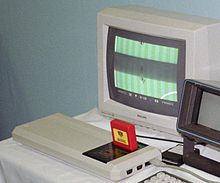
Development
[edit | edit source]The Commodore 64 Games System began a rushed development in spring of 1990 to address the unique needs of the European gaming market while Commodore prepared the C65, a planned successor to the popular C64.[1]
It is estimated that the system cost around $40 to manufacture.[2] A manufacturing issue required some early run cartridges made by Ocean to be manually drilled to fit the system.[3]
Prior to launch hopes for the system were initially high for some, with the system being heavily touted on the very first issue of Commodore Format magazine.[4] At CES 1990 the Commodore 64 Games System overshadowed the more capable Commodore CDTV at the Commodore booth,[5] an sign of the faith the company placed in their system.
Launch
[edit | edit source]I think the C64 GS will be the number one product this year.—Kelly Sumner, Marketing Manager of Commodore UK, Commodore Format[1]
The Commodore 64 Games System was released in the UK in December of 1990 for 99.99 British pounds.[6][7][8][9] At the time a typical bundle of a standard Commodore 64 and accessories cost around 149 British pounds,[10] leading to many gamers opting for the more capable computer.[11][9]
By Easter on March 31st, 1991, retailers attempted to get rid of the system, with some systems being sold for as little as 30 British pounds.[1][11]
The system would also have a launch in Denmark in 1991, with similar results.[9][11] A planned German launch was canceled.[11]
Legacy
[edit | edit source]About 20,000 Commodore 64 Games Systems were sold,[8] out of 80,000 total systems manufactured.[9] Unsold consoles were parted for use in standard Commodore 64G computers.[1][11]
The Commodore 64 Games System is often remembered as a cautionary tale, a potentially good system held back by extreme cost cutting and a lack of compatibility testing.
The Commodore 64 Games System is now often referred to as the Commodore 64 GS, or abbreviated as the C64GS. Interestingly, the shortened name used on the system itself, the C64 Games System, is rarely used by contemporary media.
Technology
[edit | edit source]The Commodore 64 Games System is essentially a regular Commodore 64, but with reduced ports and no keyboard built in.[8] The system still used an 8-bit MOS 6510 CPU clocked at 0.985MHz, 64 kilobytes of RAM, and SID sound chip.[8] The ROM included on the Commodore 64 Games System features slight alterations compared to a standard Commodore 64.[9][11] It was hoped that by forcing gamers to load games from cartridges, the superior speed and anti-piracy characteristics of the format would help improve the standing of the Commodore 64 platform in the gaming market.[1]
The default joystick shipped with the Commodore 64 Games System was the notoriously poor quality Cheetah Annihilator.[9][3]
Notable games
[edit | edit source]The Commodore 64 Games System is technically compatible with every Commodore 64 game, though since most Commodore 64 games required the use of a keyboard which could not be added to the Games System, most Commodore 64 games could not actually be played on the GS.[8] This incompatibility notably affected Terminator 2: Judgement Day, a game which was specifically advertised as compatible with the Commodore 64 Games System, yet unable to progress pass the title screen on it due to explicitly requiring keyboard input.[3][12]
Gallery
[edit | edit source]References
[edit | edit source]- ↑ a b c d e "In 1990, Commodore turned the C64 into a console. This is the story of the C64 GS, part one." (in en). Commodore Format Archive. 2020-08-28. https://commodoreformatarchive.com/in-1990-commodore-turned-the-c64-into-a-console-this-is-the-story-of-the-c64-gs/.
- ↑ "Commodore 64 – The Best Selling Computer In History – Commodore Computers: C64 VIC20 PET C128 Plus4 – 8 Bit PC's". www.commodore.ca. Retrieved 10 June 2021.
- ↑ a b c "Commodore 64 Games System Review - C64GS | Nostalgia Nerd". Retrieved 10 June 2021.
- ↑ "Commodore Format 1 (October, 1990)" (in en). Commodore Format (1). October 1990. https://commodoreformatarchive.com/issue-review-cf-1-october-1990/.
- ↑ "What games were released for the C64 GS?" (in en). Commodore Format Archive. 2021-01-11. https://commodoreformatarchive.com/new-what-games-were-released-for-the-commodore-64-gs/.
- ↑ "Consoles that won’t die: The Commodore 64". VentureBeat. 19 April 2013. https://venturebeat.com/2013/04/19/consoles-that-wont-die-commodore-64/. Retrieved 28 October 2020.
- ↑ "Commodore 64 Games System (1990 - 1991)". Museum of Obsolete Media. 19 April 2020. Retrieved 28 October 2020.
- ↑ a b c d e "Commodore 64 Games System". Retrieved 28 October 2020.
- ↑ a b c d e f "OLD-COMPUTERS.COM : The Museum". www.old-computers.com. Retrieved 10 June 2021.
- ↑ "NEW! How much did a Commodore 64 cost in the UK when CF launched, and what came in the box?". Commodore Format Archive. 2021-04-30. Retrieved 10 June 2021.
- ↑ a b c d e f "Secret Weapons of Commodore: The Game Machines: The Ultimax/Max Machine, 64GS, 64CGS". www.floodgap.com. Retrieved 10 June 2021.
- ↑ "Think Wii U sales are bad? Recall these 13 spectacular game console failures" (in en). PCWorld. 2013-08-09. https://www.pcworld.com/article/2046066/think-wii-u-sales-are-bad-recall-these-13-spectacular-game-console-failures.html.
History
[edit | edit source]Launch
[edit | edit source]The Connor Videosmarts was launched in 1986 for between $45 and $50.[1]
Videos for the Connor Videosmarts were made up to 1990.[2]
Technology
[edit | edit source]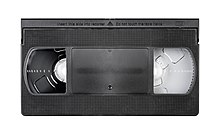
The Connor Videosmarts uses four C type batteries.[2]
Notable games
[edit | edit source]A number of educational video cassettes were made for the Conner Videosmarts.[2]
References
[edit | edit source]- ↑ a b Stevens, Mary. "VIDEOSMARTS CASSETTES TAP INTO KIDS` MINDS". chicagotribune.com. Retrieved 16 November 2020.
- ↑ a b c "Dr. Christopher J. Hopkins". www.christopherjhopkins.com. Retrieved 16 November 2020.

History
[edit | edit source]Development
[edit | edit source]The NEMO / Control-Vision is an unreleased console funded by Hasbro.[1][2]
The console began development in 1985.[2][1] Development was difficult because the idea of an interactive movie had not yet been perfected, and the film makers in charge of recording were unable to leverage tricks they could normally use to improve results in linear movies.[2] An early prototype of the console was simply a modified ColecoVision.[2] Hasbro refused to launch the product due to it's high price of $299 vastly overshooting Hasbro's goal of under $100, and pulled funding in 1988 two months before launch.[1][2]
The console had been originally planned for launch in early 1989.[1]
Legacy
[edit | edit source]Developer Tom Zito later purchased the rights to Control-Vision titles, then reworked them into games for other platforms like the Sega CD.[1][2] The release of the game Night Trap in particular is noted for being a factor in the creation of video game ratings boards.[3]
Technology
[edit | edit source]
Using linear VHS tapes played through an external VCR as it's media, the Control-Vision exploited interlacing of video to have two simultaneous videos being run, with only one of the videos being shown.[3] More streams could be added for more choices, at the cost of reducing video frame rate.[3]
Notable games
[edit | edit source]- Scene of the Crime
- Bottom of the Ninth Inning
- You Might Think
- Night Trap - Later released on other platforms, causing major controversy.
- Sewer Shark
References
[edit | edit source]| Parts of this page are based on materials from: Wikipedia: the free encyclopedia. |
- ↑ a b c d e "Only In The 80's Would They Put Video Games On A VHS Tape". Kotaku. Retrieved 8 November 2020.
- ↑ a b c d e f "Finding NEMO: The Story Behind Hasbro's 'Nintendo-Killer' - IGN". Retrieved 8 November 2020.
- ↑ a b c Parish, Jeremy (31 October 2018). "The story of NEMO, Hasbro's console that never was". Polygon. Retrieved 8 November 2020.
-
The Etch-A-Sketch Animator 2000
History
[edit | edit source]
Background
[edit | edit source]Ohio Art is a company based in Bryan, a small community in northwest Ohio.[1] The company had begun to experiement with an electronic Etch-A-Sketch when they released the original Etch-A-Skech animator, a device capable of 12 frames of animations, in 1986.[2][3] The system retailed for $139.99 and cartridges cost $29.99.[4] It's important to note that the original Etch-A-Sketch animator was essentially a digital version of the analog Etch-A-Sketch,[5] and as purely an art and animation device it did not play games.
Development
[edit | edit source]Development of the Etch-A-Sketch Animator 2000 began in 1987.[6] In 1988 Ohio Art received a patent for the original Etch-A-Sketch Animator.[7][8]
Launch
[edit | edit source]Its mother is a computer. Its father is a toy—Marketing slogan, Philadelphia Inquirer[9]
The Etch-A-Sketch Animator 2000 launched in 1988.[6][10]
Legacy
[edit | edit source]The Etch-A-Sketch Animator 2000 was not a success and production ended by 1990.[11]
A TV plug and play system, the Etch-A-Sketch ETO was launched in 2004 for $35.[12] The Ohio Art Company would later work on a different system, the K-Magic
Technology
[edit | edit source]Compute
[edit | edit source]The Etch-A-Sketch Animator was advertised as having "196K memory", as well as having "30 functions".[4]
22 images could be stored in the Etch-A-Sketch Animator 2000, and 99 animation frames using those pictures could be saved.[13] A memory cartridge was available to expand storage.[14][15]
Hardware
[edit | edit source]The Etch-A-Sketch Animator 2000 has a black and white LCD with a resolution of 60 pixels by 40 pixels.[16]
The Etch-A-Sketch Animator 2000 has a touch pad and stylus.[14][17]
The Etch-A-Sketch Animator 2000 uses six AA batteries.[14]
The system was protected by a styrofoam shell while in its box.[18][14]
The system was made in the USA with some parts sourced from Hong Kong and Japan.[19]
Original Etch-A-Sketch Animator Specs
[edit | edit source]The original Etch-A-Sketch Animator has a 4-bit Sanyo LC6523 microcontroller, two kilobytes of RAM, and an LCD screen with a resolution of 40 by 30 pixels.[20]
Game Library
[edit | edit source]Three games were released for the Etch-A-Sketch Animator 2000.[21]
- Putt-Nuts - 18 hole Mini golf game.[21][6] Has a two player mode.[22]
- Flyby - Flight simulator.[23][6] Todd Marshall worked on this game.[24]
- Overdrive - Racing game.[6]
Gallery
[edit | edit source]External Resources
[edit | edit source]References
[edit | edit source]- ↑ "History of Ohio Art Company Metal Lithography Ohio Art Company". Retrieved 16 November 2020.
- ↑ "Disappointing Gifts, 1986 Edition: The Etch A Sketch Animator". TechCrunch. Retrieved 16 November 2020.
- ↑ "Significant dates in Etch A Sketch history". The Blade. Retrieved 16 November 2020.
- ↑ a b Magazines, Hearst. Popular Mechanics. Hearst Magazines. p. 27. Retrieved 16 November 2020.
- ↑ Belkin, Lisa (25 December 1986). "FOR ONCE, A CALM TOY SEASON (Published 1986)". The New York Times. https://www.nytimes.com/1986/12/25/business/for-once-a-calm-toy-season.html.
- ↑ a b c d e "Etch A Sketch invented by Arthur Granjean in year 1959". targetstudy.com. Retrieved 16 November 2020.
- ↑ "Etch A Sketch!". hlflegal.com. Retrieved 16 November 2020.
- ↑ "Electronic sketching device". 13 December 1985. Retrieved 16 November 2020.
- ↑ "ELECTRIFYING GIFTS & GIZMOS: FOR KIDS, TOYS THAT TEACH" (in en). search.proquest.com (Philadelphia Inquirer). November 24, 1988. https://search.proquest.com/docview/1833082226?pq-origsite=summon. Retrieved 19 November 2020.
- ↑ "A Revival for Makers of Classic Toys (Published 1988)". The New York Times. 9 March 1988. https://www.nytimes.com/1988/03/09/business/a-revival-for-makers-of-classic-toys.html.
- ↑ "History of The Ohio Art Company – FundingUniverse". www.fundinguniverse.com. Retrieved 16 November 2020.
- ↑ Zipern, Andrew (12 August 2004). "NEWS WATCH: TOYS; A Classic Pad Goes Digital, But Is It Shakable? (Published 2004)". The New York Times. Retrieved 16 November 2020.
- ↑ "Etch-A-Sketch Animator ilovethe80s.com". ilovethe80s.com. Retrieved 16 November 2020.
- ↑ a b c d "A closer look at the Ohio Art Etch A Sketch Animator 2000 Family Entertainment System". Imgur. Retrieved 16 November 2020.
- ↑ "BACK TO THE FUTURE: The Gadget Show closes at - ProQuest". search.proquest.com. Retrieved 19 November 2020.
- ↑ "English: My Etch A Sketch Animator 2000". 21 January 2013. Retrieved 16 November 2020.
- ↑ "Unique Etch A Sketch Animator 2000 Game System Review Gamester 81". Retrieved 16 November 2020.
- ↑ "The Etch A Sketch Animator 2000 Ohio Art Rare-with Box And Original Pen #1936265130". Worthpoint. Retrieved 16 November 2020.
- ↑ "Etch-A-Sketch Animator 2000 and "Overdrive" - Unboxing, Gameplay, & Review". Retrieved 16 November 2020.
{{cite web}}: Text "Retro Game Living Room" ignored (help) - ↑ "Etch-A-Sketch Animator: Demo and Repair". Retrieved 16 November 2020.
- ↑ a b "Review and full play through of Putt-Nuts for Etch-A-Sketch Animator 2000". Retrieved 16 November 2020.
{{cite web}}: Text "Retro Game Living Room" ignored (help) - ↑ "Unique Etch A Sketch Animator 2000 Game System Review Gamester 81". Retrieved 16 November 2020.
- ↑ "video game: Flyby - The Ohio Art Company". Google Arts & Culture. Retrieved 16 November 2020.
- ↑ "Atari Compendium". www.ataricompendium.com. Retrieved 16 November 2020.

History
[edit | edit source]Do you believe in magic? You will.—Halcyon advertising slogan, RDI marketing flyer[1]
RDI was a small company based out of Carlsbad, California.[2] The company was headed by Rick Dyer, and had prior experience in the industry, most notably producing Don Bluth's milestone laserdisk arcade game Dragon's Lair.[3][4]
The Halcyon was set to release in 1985 with the voice controlled console costing either $2,500,[5] or $2,100[6] and the non-voice enabled console costing $1,800.[6] Though the produced consoles were never sold at retail, up to ten Halcyon consoles exist from kits sent to investors.[5][7] RDI projected their own first year sales to be 25,000 units sold,[8] though it is impossible to say if this would have actually occurred had the console actually launched.
Technology
[edit | edit source]The Halcyon used an 8-bit Z80B CPU clocked at 6 megahertz and had 64 kilobytes of RAM.[9]
The Halcyon could interpret 200 words.[2]
Released games
[edit | edit source]- Thayer's Quest[10]
- NFL Football LA Raiders vs SD Chargers[10]
External Resources
[edit | edit source]- Video Game Kraken - Halcyon by RDI video systems page.
- Handheld Museum - RDI Halcyon page.
References
[edit | edit source]| Parts of this page are based on materials from: Wikipedia: the free encyclopedia. |
- ↑ Allison, Fraser; Carter, Marcus; Gibbs, Martin (March 2020). "Word Play: A History of Voice Interaction in Digital Games". Games and Culture. 15 (2): 91–113. doi:10.1177/1555412017746305.
{{cite journal}}:|access-date=requires|url=(help) - ↑ a b Corporation, Bonnier. Popular Science. Bonnier Corporation. Retrieved 3 December 2020.
- ↑ "10 Crazy Things You Never Knew About Dragon's Lair". TheGamer. 2020-04-20. https://www.thegamer.com/crazy-things-never-knew-dragons-lair/.
- ↑ "RDI Video Systems". Wikipedia. 2021-04-08. Retrieved 28 May 2021.
- ↑ a b Rochefort, Simone de (1 March 2018). "More than a machine: The history of Halcyon" (in en). Polygon. https://www.polygon.com/videos/2018/3/1/17063348/halcyon-rare-console-history. Retrieved 28 October 2020.
- ↑ a b "After the prototype PlayStation: six more obscure games consoles" (in en). the Guardian. 7 July 2015. https://www.theguardian.com/technology/2015/jul/07/prototype-nintendo-playstation-obscure-games-consoles-snes-cd.
- ↑ "MGs Game Take: The True Holy Grails of Video Game Hardware - "The Majors" - Beyond the Mind's Eye - Thoughts & Insights from Marriott_Guy". www.rfgeneration.com. Retrieved 28 October 2020.
- ↑ Television Digest, with Consumer Electronics. Television Digest, Incorporated. Retrieved 3 December 2020.
- ↑ "Home Page". Video Game Console Library. Retrieved 28 October 2020.
- ↑ a b "Halcyon (console)". Wikipedia. 6 March 2021. Retrieved 28 April 2021.
History
[edit | edit source]The IM-26 was released in the Soviet Union in 1988.[1][2] The system is noted for it's similarity to the Digi Casse.[1][3]
The console would slightly outlive the Soviet Union, which dissolved on the 24th of December in 1991.[4] Development for the IM-26 stopped after 1992.[1]
Technology
[edit | edit source]The console display was included in game cartridges.[1][3]
The IM-26 is powered by two LR43 batteries.[3]
Gallery
[edit | edit source]External Resources
[edit | edit source]- Video Game Kraken - IM-26 page.
- Game Medium - IM-26 page.
References
[edit | edit source]- ↑ a b c d "IM-26 by Electronika – The Video Game Kraken". Retrieved 16 November 2020.
- ↑ "Electronika IM-26". Retrieved 20 December 2020.
- ↑ a b c "Pocket Legion - Elektronika IM-26 - YouTube". www.youtube.com. Retrieved 16 November 2020.
- ↑ "The Fall of the Soviet Union | CES at UNC". https://europe.unc.edu/iron-curtain/history/the-fall-of-the-soviet-union/.
-
A Playtime Light Games console.
History
[edit | edit source]The Grandstand Light Games system was a projector based console released in 1988.[1] It is one of the few consoles that elected to go with a projector based design, alongside its contemporary the Proscreen, and the much later 2020 console the BL6.
Technology
[edit | edit source]The Grandstand Light Games uses a projector to display graphics.[1] The projector shines through a LCD in the cartridge, which produces the graphics in lieu of slides.[2][3][4]
The top of the console includes a cartridge slot.[5]
Games
[edit | edit source]There are at least nine cartridges for the Light Games console.[6]
External Resources
[edit | edit source]- Handheld Museum - Playtime Light Games page.
- Game Medium - Light Games page.
- Video Game Console Library - Gallery of Educational Systems including Light Games.
References
[edit | edit source]- ↑ a b "Gallery of Educational Systems". Video Game Console Library. Retrieved 16 November 2020.
- ↑ "Grandstand Light Games". Retrieved 16 November 2020.
- ↑ See photo of console and cartridge.
- ↑ Barsanti, Sam; Hughes, William (22 March 2021). "The rise and fall of the Game Boy's weirdest rivals" (in en-us). The A.V. Club. https://www.avclub.com/the-game-com-cometh-the-rise-and-fall-of-the-game-boy-1846501180/slides/3.
- ↑ "Playtime Light Games". www.handheldmuseum.com. Retrieved 16 November 2020.
- ↑ "Grandstand Light Games". Retrieved 20 December 2020.
History
[edit | edit source]Development
[edit | edit source]On October 30th, 1986 LJN filed a patent with the US Patent office concerning technology used in the device.[1]
Launch
[edit | edit source]The LJN Video Art was launched in 1987.[2] The system cost around $100.[3] A rap jingle was used to promote the device.[4]
Legacy
[edit | edit source]The LJN Video Art was discontinued in either 1988[5] or 1989.[6] The discontinuation was spurred in part due to difficulties faced by LJN during that time.[5]
Unlike most platforms, the LJN Video Art is perhaps better know for events following discontinuation. In 1990 patents concerning the Video Art were transferred from LJN to an individual.[1] From 1993 to 1995 a court battle ensued over LJN Video Art patents and the popular SNES software Mario Paint, though this usage was ultimately ruled as non-infringing.[7][8]
Much later, the system gained notoriety online for it's poor design.[9]
Technology
[edit | edit source]There does not appear to be any reliable information on technology used by the LJN Video Art.
The system supported drawing with 16 colors.[4][10]
New York Magazine suggested saving art drawn on the LJN Video Art by recording to videotape.[3]
Notable games
[edit | edit source]About 8 cartridges were released for the LJN Video Art, with Marvel, Disney, and Loony Toons licensed releases.[2]
- A Trip To The Zoo[6]
- Disney Coloring Book[6]
- Disney Story Book[6]
- Looney Tunes[6]
- Marvel Super-Heroes[6]
- My Dream Day[6]
- My Favorite Doll[6]
- On the Move[6]
- Video Art Activity Cartridge[6]
References
[edit | edit source]| Parts of this page are based on materials from: Wikipedia: the free encyclopedia. |
- ↑ a b "Video art electronic system". 1986-10-30. Retrieved 18 May 2021.
- ↑ a b "The LJN Video Art System Review - Gamester81". Retrieved 31 October 2020.
- ↑ a b LLC, New York Media. New York Magazine. New York Media, LLC. Retrieved 3 December 2020.
- ↑ a b "1987 LJN Video Art commercial". Retrieved 3 December 2020.
- ↑ a b "Video Art by LJN Toys Ltd – The Video Game Kraken". Retrieved 7 November 2020.
- ↑ a b c d e f g h i j "LJN Video Art". Wikipedia. 2021-04-07. Retrieved 18 May 2021.
- ↑ "Edward L. Gussin, Plaintiff-appellant, v. Nintendo of America, Inc., Defendant-appellee, 62 F.3d 1433 (Fed. Cir. 1995)". Justia Law. Retrieved 18 May 2021.
- ↑ "The Story of Mario Paint | Gaming Historian". Retrieved 18 May 2021.
- ↑ "好きなゲームをクソゲーと言われ悔しくて作家デビューした人物の“ゲームSF小説”を読み解く、そこにはゲームレビューの可能性が秘められていた" (in ja). IGN Japan. 9 July 2017. https://jp.ign.com/videogamewithnoname/15365/feature/sf.
- ↑ Schellenberg, Kathryn. Computers in Society. Dushkin. ISBN 978-0-87967-727-5. Retrieved 3 December 2020.
-
The Sega Master System console and controller.
History
[edit | edit source]
Launch
[edit | edit source]The Sega Master System was preceded by the SG-1000.
On October 20th, 1985, the Sega Master System launched in Japan.[1]
Legacy
[edit | edit source]Discontinued in Europe in 1996, the Master System sold over 20 million units.[2] The Master System saw it's greatest success in Brazil, where it enjoyed a status similar to the NES in North America and remained popular and in production even in the year 2016.[3] Elsewhere the Master System was a more modest success, where it sold 1 million units in Japan, 2 million units in North America, and 6.8 million units in Europe.[1]
The Sega Master System was followed by the Sega Mega Drive and Sega Genesis.
Technology
[edit | edit source]
Compute
[edit | edit source]The Sega Master System is powered by an 8-bit Zilog Z80 processor clocked at 3.58 megahertz, with an identical second source NEC D780C-1 CPU being used alternitively sometimes.[4][5]
The Master System has eight kilobytes of RAM and 16 kilobytes of low latency VRAM.[4]
The Master System uses a modified TMS9918 processor, called the Video Display Processor, with added features over the base design by adding mode 4.[4][6] The VDP also includes a Texas Instruments SN76489 for sound.[4][7][8]
Accessories
[edit | edit source]SegaScope 3D Glasses
[edit | edit source]
The glasses were released at a cost of ~$50 in North America, Europe, and Japan in 1987.[9]
Game case
[edit | edit source]Games boxes for the Sega Master System games were made of durable plastic.[10] Box art for these games was relatively uniform.[11][12]
Notable games
[edit | edit source]1986
[edit | edit source]Alex Kidd
[edit | edit source]Read more about Alex Kidd in Miracle World on Wikipedia.
1987
[edit | edit source]Phantasy Star
[edit | edit source]Phantasy Star is noted as an early example of a game with a female protagonist.[13]
Read more about Phantasy Star on Wikipedia.
Gallery
[edit | edit source]Master System Console
[edit | edit source]Console Variants
[edit | edit source]Motherboard
[edit | edit source]Marketing
[edit | edit source]-
Sega Master System logotype.
-
Sega Mark III logotype.
External Resources
[edit | edit source]References
[edit | edit source]| Parts of this page are based on materials from: Wikipedia: the free encyclopedia. |
- ↑ a b "Sega Consoles: What You Need to Know About the Retro Game Giant". CBR. 5 May 2019. https://www.cbr.com/sega-consoles-retro-game-history/. Retrieved 24 October 2020.
- ↑ "Sega Master System (1986 - 1996)". Museum of Obsolete Media. 26 February 2014. Retrieved 28 October 2020.
- ↑ "Brazil's Obsession With the Sega Genesis Won't Slow Down" (in en-us). Gizmodo. https://gizmodo.com/brazils-obsession-with-the-sega-genesis-wont-slow-down-1788698522. Retrieved 24 October 2020.
- ↑ a b c d "Sega Master System Architecture A Practical Analysis". Rodrigo's Stuff. 12 October 2020. Retrieved 7 November 2020.
- ↑ "Prototype Master System: M404 - Development - SMS Power!". www.smspower.org. Retrieved 7 November 2020.
- ↑ "TMS9918a - Development - SMS Power!". www.smspower.org. Retrieved 7 November 2020.
- ↑ Langston, J. B. (11 October 2020). "jblang/SN76489". Retrieved 7 November 2020.
- ↑ "SEGA MASTER SYSTEM TECHNICAL INFORMATION". Retrieved 7 November 2020.
- ↑ "That Time Nintendo and Sega Introduced 3D Gaming, In 1987". Kotaku. Retrieved 24 October 2020.
- ↑ "Collecting Sega Master System Games Is A Huge Pain In The Ass" (in en-us). Kotaku. https://kotaku.com/collecting-sega-master-system-games-is-a-huge-pain-in-t-1795243730. Retrieved 24 October 2020.
- ↑ "Happy 25th Birthday, Sega Master System!". Kotaku. Retrieved 24 October 2020.
- ↑ "The Laziest Box Art in Video Game History" (in en-us). Kotaku. https://kotaku.com/the-laziest-box-art-in-video-game-history-5886757. Retrieved 27 October 2020.
- ↑ "A Brief History of Women in Gaming: The 1980s - The Strong National Museum of Play". Google Arts & Culture. Retrieved 14 December 2020.
-
The Nichibutsu My Vision console.
History
[edit | edit source]Launch
[edit | edit source]The My Vision was launched briefly in 1983 only in Japan for 39,800 yen, and also known as the KH-1000.[1]
Preservation
[edit | edit source]The My Vision is supported by the open source z88DK development kit.[2]
Technology
[edit | edit source]Compute
[edit | edit source]The My Vision used an 8-bit Z80 CPU clocked at 3.57 megahertz.[3]
The system had 2 kilobytes of RAM.[3]
Graphics
[edit | edit source]The My Vision used a Texas Instrument TMS9928 chip with 16 kilobytes of video RAM for graphics[3], and had composite and RF output.[1] The console had a 16 color palette.[4]
Audio
[edit | edit source]A General Instrument AY-3-8910 was used for generating audio.[3] Sound was produced by a speaker inside the console.[5]
Expansion
[edit | edit source]The console had a cartridge slot, as well as a port for expanding Majohng games.[1] Two consoles could be linked for multiplayer over a link cable.[5]
The system used per game overlays for it's integrated keys to explain the controls.[6]
Games
[edit | edit source]Six games were released for the My Vision, with each game costing 4,500 yen.[5]
External Resources
[edit | edit source]- Game Medium - My Vision page.
- Video Game Kraken - My Vision page.
References
[edit | edit source]| Parts of this page are based on materials from: Wikipedia: the free encyclopedia. |
- ↑ a b c "Nichibutsu My Vision". Video Game Console Library. Retrieved 23 October 2020.
- ↑ "z88dk/z88dk". GitHub. Retrieved 23 October 2020.
- ↑ a b c d "z88dk/z88dk". GitHub. Retrieved 23 October 2020.
- ↑ Manikas, Pantelis. "Nichibutsu My Vision". News & Reviews for Videogames & Gaming Consoles consall.eu. Retrieved 20 December 2020.
- ↑ a b c "My Vision by Nichibutsu – The Video Game Kraken". Retrieved 23 October 2020.
- ↑ "My Vision - Ultimate Console Database". ultimateconsoledatabase.com. Retrieved 23 October 2020.
- ↑ a b c d e f "My Vision". Wikipedia. 29 June 2020. Retrieved 23 October 2020.
-
The iconic Japanese Famicom and controllers.
-
The iconic North American NES and controller.
History
[edit | edit source]Development
[edit | edit source]Famicom Development
[edit | edit source]The Famicom, and by extension the Nintendo Entertainment System, was proceeded by the Color TV-Game Series. Development was lead by noted engineer Masayuki Uemura,[1][2] who was asked to develop a new more competitive and advanced home gaming system by Nintendo President Hiroshi Yamauchi during a phone call to the Uemura house.[3] This was part of a larger strategy in which Hiroshi Yamauchi decided to reinvest profits from the Color TV Game and Game and watch systems into further game products.[4]
Plans for the system originally called for a 16-bit CPU but a more economical 8-bit CPU was chosen.[5][6] Nintendo was able to further optimize the cost of the CPU by placing a very large bulk order with Ricoh,[7] who had an underutilized factory at the time.[8] This technical choice had an additional unexpected effect of attracting developer Satoru Iwata to the system, who would later become a key developer at Nintendo, and later serve as its president.[9]
NES Development
[edit | edit source]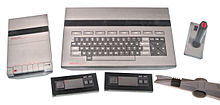
In 1983 Nintendo approached Atari about releasing their console in the USA, and agreed on it until a misunderstanding at CES 1983 sunk the deal.[10]
Designer Lance Barr was charged with refining the design of the NES to make it appealing to American audiences while keeping costs low,[11] ultimately creating an iconic design.
Nintendo would attempt to make an user avatar system for the console, but this would ultimately be scrapped and shelved until the release of Miis on the Nintendo Wii decades later.[12][13]
Launch
[edit | edit source]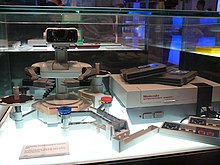
Now you're Playing with Power!—NES Slogan, [14]
The Family Computer (Famicom) was released in Japan on July 15, 1983 at a cost of 14,800 yen.[4][15] Nintendo later released the similar Nintendo Entertainment System (NES) to international markets. The NES saw its American release in 1985, and European release in 1986.[16][15] In the United States the NES was a dominant player in the market,[17] and was so popular that it began to alter how people discussed gaming, with many people using the word "Nintendo" to describe video games in general for a time, even those not made by Nintendo.[18][19] Fearing the word "Nintendo" might become a generic trademark, Nintendo promoted the word "Game Console" instead.[20]
Internationally the NES received significant challenges from the Sega Master System particularly in South America and Europe.[17]
1983 also saw the launch of the Sharp Game Television (Also known as the Sharp Nintendo Television or as the Sharp C1 NES TV) which integrated a Famicom with a 19 inch TV costing 145,000 yen or a 14 inch TV that cost 93,000 yen.[21]
Seal of Quality
[edit | edit source]To avoid negative associations with video game consoles following the video game crash of 1983, Nintendo used careful wording in its marketing to brand the NES as an "Entertainment" system, rather then a game console.[17] To avoid a repeat of the poor quality games that caused the crash, Nintendo required licensed developers to limit game releases to two a year, as well as to censor overt depictions of gore and other sensitive subjects.[17] These policies were a cause of friction between some developers and Nintendo.[22]
Later on in the system life, an Atari subsidiary would break the lockout protection used to enforce Nintendo's licensing, though this resulted in legal challenges.[23] This inspired other companies to make their own bypass, though methods that used a charge pump or negative voltage spike could damage the system.[23][24]
Smash hit
[edit | edit source]The NES had a limited United States of America launch in New York City and Los Angeles October 15th, 1985, with a nationwide release a year later.[25][26] These first markets were picked to see if the NES could survive in difficult markets, and retailers were persuaded to carry the system by only needing to pay for systems sold, with unsold stock being fully returnable.[26] The 1989 television show Captain N was used to promote Nintendo products.[27]
The Famicom Tiler was jointly launched by Nintendo and Sharp in 1989 at a cost of 43,000 yen, and added video editing features and S-Video to improve screen captures for media outlets.[28]
International Adoption
[edit | edit source]Some regions such as India saw officially licensed versions of the NES released under other names.[29][30][31]
Other clones were unlicensed, like the Dendy console, made in Taiwan for the newly accessible Russian market where it was legal due to a lack of Intellectual property laws at the time.[32] This later led to an official partnership between Dendy and Nintendo.[32][33]
NES 101
[edit | edit source]In 1993 the NES 101, a cost reduced version of the NES was released, removing the composite output and lowering the price to $49.99.[34]
Legacy
[edit | edit source]61.91 million NES and Famicom consoles were sold.[35][36]
The Nintendo Entertainment System and the Famicom was succeeded by the Super Nintendo Entertainment System and the Super Famicom.
Nintendo stopped producing new NES units in 1995, new Famicom systems in 2003, and stopped repairing Famicom systems in 2007.[17]
Technology
[edit | edit source]Compute
[edit | edit source]The NES CPU was a reduced feature version of the MOS 6502, a Rioch 2A03.[37] The CPU was clocked at 1.789773Mhz in NTSC regions, and at 1.773447Mhz in PAL regions.[37]
The NES had two kilobytes of RAM and two kilobytes of video RAM.[37][38]
Graphics
[edit | edit source]The NES had a Rioch 2C02 Picture Processing Unit (PPU) for graphical output, supporting up to 52 colors and 64 sprites.[37] The PPU was clocked at 5.37 megahertz.[39] The PPU had 256 bytes of memory located directly on chip, which was known as Object Attribute Memory.[39] The PPU had a number of limitations on what it could do simultaniously, notably limiting sprites to use only 3 colors at a time, with an additional transparency color.[39][40] However, clever programmers and artists often found ways to lean into or even subvert these limitations through guile and wit. The PPU of the NES was quite capable for it's time, and gave the system a graphical edge over much of it's competition.
Audio
[edit | edit source] |
|
| Problems listening to this file? See media help. | |
The Nintendo Entertainment System had 2 pulse wave channels, 1 triangle wave channel, 1 noise channel, and 1 DPCM channel.[37] Games for the Famicom often featured much better audio then on the Nintendo Entertainment System, as the Famicom has additional pins for cartridge based sound chips.[41] A number of different additional audio chips were used in Famicom cartridges.[42]
Controllers
[edit | edit source]NES Hands Free Controller
[edit | edit source]Nintendo of America developed a hands free controller for disabled gamers, among the earliest of it's kind.[43] A chin mounted joystick and breath tube served as input.[43] The controller was chest mounted and weighed 2.5 pounds (1.1 kg).[44] A prototype was tested at the Children's Orthopedic Hospital in Seattle, Washington,[44] near where Nintendo of America was headquartered.
Notable Games
[edit | edit source]
Dates are for the earliest release on the Famicom or NES. International releases often occurred one or two years later. |
1983
[edit | edit source]Mario Bros.
[edit | edit source]A recreation of the arcade game.
Read more about Mario Bros. on Wikipedia.
1984
[edit | edit source]1985
[edit | edit source]Super Mario Bros
[edit | edit source]First version of Mario as an adventure platformer.
From here on, designers Shigeru Miyamoto, Takashi Tezuka, developer Toshihiko Nakago and musician Koji Kondo would typically work together as a unit on future projects, to great success.[45]
Read more about Super Mario Bros 1 on Wikipedia.
Wrecking Crew
[edit | edit source]An early Mario puzzle-platformer.
Read more about Wrecking Crew on Wikipedia.
1986
[edit | edit source]- Dragon Quest - Popular RPG
- Kid Icarus
- Ghosts 'n Goblins
The Legend of Zelda
[edit | edit source]
The Legend of Zelda is one of the most iconic Famicom and NES games, mainly because of the expansive multimedia franchise it started. Sigeru Miyamoto was inspired to make this game by his personal experience of exploring the countryside and caves as a child.[46]
Metroid
[edit | edit source]Metroid is noted for being an early game with a female protagonist.[47]
Read more about Metroid on Wikipedia.
1987
[edit | edit source]- Zelda II: The Adventure of Link - 2D scroller adaptation of the Zelda format.
- Mega Man - Known as Rockman in Japanese markets.
- Rad Racer
- Punch-Out!!
- Nakayama Miho no Tokimeki High School
Final Fantasy
[edit | edit source]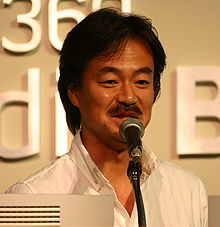
The first game in the popular RPG series.
The game was named Final Fantasy because the developers thought it would be their final game before Square went bankrupt.[48]
Many elements of Final Fantasy appear to be inspired by Advanced Dungeons and Dragons.[49][50]
Read more about Final Fantasy I on Wikipedia.
Metal Gear
[edit | edit source]Early popular stealth game.
The NES port of Metal Gear was made without the involvement of Hideo Kojima, who disliked the NES version.[51]
Read more about Metal Gear on Wikipedia.
1988
[edit | edit source]- Super Mario Bros. 2 - Remake of the Japanese game Doki Doki Panic.
- Super Mario Bros. 3
- Mega Man 2 - The best selling Mega Man game.[52]
- Contra
- Ninja Gaiden
Famicom Detective Club The Missing Heir Volumes 1 and 2
[edit | edit source]
An Japan only primeval visual novel that notably strayed from adventure game conventions to make a more story focused game.[53]
Character Ayumi Tachibana would later be considered as a Super Smash Brothers Melee character.[54][55]
Read more about the Famicom Detective Club series on Wikipedia.
1989
[edit | edit source]- Teenage Mutant Ninja Turtles
- Mendel Palace / Quinty
- A Boy and His Blob: Trouble on Blobolonia
- Faria: A World of Mystery and Danger!
Mother
[edit | edit source]The first game in the Mother series.
A documentary was produced about an unreleased prototype english cartridge.[56]
Read more about Mother on Wikipedia.
Tetris
[edit | edit source]Popular game from the Soviet Union, licensed to Nintendo for home consoles in the west.
In 2021 a new technique for the NES version of the game was discovered where pressure was applied to the back of the controller to allow for faster inputs, allowing world records to be broken.[57][58]
Read more about Tetris on Wikipedia.
Famicom Detective Club The Girl Who Stands Behind Volumes 1 and 2
[edit | edit source]The second entry in the then Japan exclusive Famicom Detective Club series.[53] Series director Yoshio Sakamoto was able to better work around system limitations to his satisfaction in this entry.[53]
Read more about the Famicom Detective Club series on Wikipedia.
1990
[edit | edit source]Final Fantasy III
[edit | edit source]Not to be confused with the North American Final Fantasy III for the SNES, which was Final Fantasy VI in other regions but had its name changed in North America to avoid skipping missed releases.[59] This was done to avoid confusion at the time, though it caused some confusion later.[59]
Final Fantasy III was the first Final Fantasy series game to break a million sales.[60]
Read more about Final Fantasy III on Wikipedia.
1991
[edit | edit source]1993
[edit | edit source]Kirby's Adventure
[edit | edit source]The second game in the Kirby series. It introduced a mechanic allowing the player to copy enemy abilities,[61] becoming a series staple from there onward.
The game is considered by many to be make good use of the technical capabilities of the NES, having good graphics given the system limitations.[62]
Read more about Kirby's Adventure on Wikipedia.
Gallery
[edit | edit source]Famicom
[edit | edit source]NES
[edit | edit source]NES 101
[edit | edit source]AV Famicom
[edit | edit source]Sharp Twin Famicom
[edit | edit source]Other Console Variants
[edit | edit source]Controllers
[edit | edit source]Accessories
[edit | edit source]Games
[edit | edit source]Motherboards
[edit | edit source]Development
[edit | edit source]Marketing
[edit | edit source]-
Family Computer (Famicom) logo.
-
Nintendo Entertainment System (NES) logo.
Clone Consoles
[edit | edit source]Trivia
[edit | edit source]A third party company, Power 10 Inc., made a early motion controller for the NES that used mercury switches called the Hot Stik.[63]
Further reading
[edit | edit source]There is a WikiBook on NES programming.
External Resources
[edit | edit source]- Video Game Console Library - Famicom/NES page.
- Nintendo UK Blog - Post showing design documents for the original Legend of Zelda.
References
[edit | edit source]| Parts of this page are based on materials from: Wikipedia: the free encyclopedia. |
- ↑ "「ファミコン」生みの親・上村雅之さん死去 78歳|秋田魁新報電子版" (in ja). 秋田魁新報電子版. https://www.sakigake.jp/news/article/20211209OR0114/?nv=ent.
- ↑ "Masayuki Uemura, Creator Of The NES And SNES, Dies At 78" (in en-us). Kotaku. https://kotaku.com/masayuki-uemura-creator-of-the-nes-and-snes-dies-at-7-1848184264.
- ↑ "Iwata Asks". iwataasks.nintendo.com. https://iwataasks.nintendo.com/interviews/#/wii/mario25th/1/0.
- ↑ a b Hongo, Jun (15 July 2013). "Nintendo brought arcade games into homes 30 years ago". The Japan Times. https://www.japantimes.co.jp/news/2013/07/15/reference/nintendo-brought-arcade-games-into-homes-30-years-ago/. Retrieved 25 October 2020.
- ↑ "NintendoLand - The best site for info about Nintendo's classic video games.". web.archive.org. 25 May 2009. https://web.archive.org/web/20090525223925/http://www.nintendoland.com/home2.htm?nes%2Fhistory.htm.
- ↑ "NES". scf.usc.edu. Retrieved 7 December 2020.
- ↑ Arsenault, Dominic. Super Power, Spoony Bards, and Silverware: The Super Nintendo Entertainment System. MIT Press. ISBN 978-0-262-34150-9. Retrieved 20 December 2020.
- ↑ "Iwata Asks". iwataasks.nintendo.com. https://iwataasks.nintendo.com/interviews/#/wii/mario25th/1/1.
- ↑ Lane, Gavin (9 December 2021). "Masayuki Uemura, The Nintendo Engineer Who Helped Define The Modern Games Console". Nintendo Life. https://www.nintendolife.com/features/masayuki-uemura-the-nintendo-engineer-who-helped-define-the-modern-games-console.
- ↑ "Feature: Remember When Atari Turned Down Nintendo And Sega?". Nintendo Life. 3 February 2020. https://www.nintendolife.com/news/2020/02/feature_remember_when_atari_turned_down_nintendo_and_sega. Retrieved 23 October 2020.
- ↑ "Lance Barr Interview". nintendojo ~ a site to see. 13 February 2006. https://web.archive.org/web/20060213124455/http://www.nintendojo.com/interviews/view_item.php?1130801472.
- ↑ "GDC: Miyamoto Keynote Extend Extra" (in en-us). Wired. https://www.wired.com/2007/03/gdc-miyamoto-ke/.
- ↑ "Why Nintendo is Bringing Back Miis". Retrieved 1 March 2021.
- ↑ Koch, Cameron (21 July 2016). "Nintendo Brings Back Retro 'Now You're Playing With Power' Slogan For New NES Classic Edition Ad" (in en). Tech Times. https://www.techtimes.com/articles/170917/20160721/nintendo-brings-back-retro-now-youre-playing-with-power-slogan-for-new-nes-classic-edition-ad.htm.
- ↑ a b Sottek, T. C. (15 July 2013). "The Nintendo Famicom turns 30 years old today" (in en). The Verge. https://www.theverge.com/2013/7/15/4524758/NES-famicom-30-year-anniversary. Retrieved 19 October 2020.
- ↑ "Nintendo Entertainment System Video Game Console". Smithsonian Institution. Retrieved 18 October 2020.
- ↑ a b c d e Cunningham, Andrew (15 July 2013). "The NES turns 30: How it began, worked, and saved an industry" (in en-us). Ars Technica. https://arstechnica.com/gaming/2013/07/time-to-feel-old-inside-the-nes-on-its-30th-birthday/. Retrieved 19 October 2020.
- ↑ Ward, Cassidy (5 June 2019). "Science Behind the Fiction: How Nintendo saved and redefined the game industry". SYFY WIRE. Retrieved 20 January 2021.
- ↑ "Why old people call my Playstation 4..... "nintendo"? - PlayStation 4". gamefaqs.gamespot.com. Retrieved 20 January 2021.
- ↑ "'Genericide': When brands get too big" (in en). The Independent. 18 January 2019. https://www.independent.co.uk/news/business/analysis-and-features/genericide-when-brands-get-too-big-2295428.html.
- ↑ "This Nintendo Was Inside A Television Set" (in en-us). Kotaku. https://kotaku.com/this-nintendo-was-inside-a-television-set-5787855. Retrieved 27 October 2020.
- ↑ "The Untold Story of Maniac Mansion". Wierd (Magazine-1.04). 04/01/1993. https://www.wired.com/1993/04/nintendo-2/.
- ↑ a b "That Time Atari Cracked The Nintendo Entertainment System". Hackaday. 22 October 2018. https://hackaday.com/2018/10/22/that-time-atari-cracked-the-nintendo-entertainment-system/#more-329497. Retrieved 25 October 2020.
- ↑ "How Third-Party Game Devs Reverse-Engineered Their Way Onto Your Consoles (and Into Your Heart)". www.vice.com. Retrieved 28 November 2020.
- ↑ "The NES Was Once So Rare You Could Only Get It In Two Cities" (in en-us). Kotaku. https://kotaku.com/the-nes-was-once-so-rare-you-could-only-get-it-in-two-c-1686643953. Retrieved 27 October 2020.
- ↑ a b "Oct. 18, 1985: Nintendo Entertainment System Launches" (in en-us). Wired. https://www.wired.com/2010/10/1018nintendo-nes-launches/. Retrieved 27 October 2020.
- ↑ Weber, Rachel (3 March 2017). "Flashback: Nintendo's Gamer Cartoon 'Captain N: The Game Master'". Rolling Stone. https://www.rollingstone.com/culture/culture-news/flashback-nintendo-entertains-gamers-with-captain-n-the-game-master-cartoon-124904/.
- ↑ "The Nintendo Console From The 80s Made For Recording Gameplay Footage" (in en-us). Kotaku. https://kotaku.com/the-nintendo-console-from-the-80s-that-could-record-gam-1739086864. Retrieved 27 October 2020.
- ↑ Patil, Siddharth (12 May 2016). "Nintendo And India :: A complicated Love Story". Gameffine. Retrieved 10 December 2020.
- ↑ Ghoshal, Abhimanyu (30 December 2017). "Why has Nintendo ignored India for 30 years?". The Next Web. Retrieved 10 December 2020.
- ↑ "The NES Samurai boxed!". Consolevariations. Retrieved 10 December 2020.
- ↑ a b Calvin, Alex (17 December 2017). "How a counterfeit NES console opened up the Russian games market". Eurogamer. Retrieved 10 December 2020.
- ↑ Muradov, Roman (23 October 2017). "Dendy's Dream Debased". Medium. Retrieved 10 December 2020.
- ↑ Byford, Sam (11 July 2019). "A brief history of cutdown game consoles" (in en). The Verge. https://www.theverge.com/circuitbreaker/2019/7/11/20690011/nintendo-switch-lite-game-console-redesign-xbox-playstation. Retrieved 19 October 2020.
- ↑ "Genesis vs. SNES: By the Numbers - IGN". Retrieved 13 November 2020.
- ↑ "IR Information : Sales Data - Dedicated Video Game Sales Units". Nintendo Co., Ltd. Retrieved 14 November 2020.
- ↑ a b c d e "NES Programming - Wikibooks, open books for an open world". en.wikibooks.org. Retrieved 25 October 2020.
- ↑ "Nintendo Family Computer (Famicom) Teardown". iFixit. 1 July 2010. Retrieved 29 October 2020.
- ↑ a b c Cunningham, Andrew (9 December 2021). "The NES: How it began, worked, and saved an industry" (in en-us). Ars Technica. https://arstechnica.com/gaming/2021/12/time-to-feel-old-inside-the-nes-on-its-30th-birthday/.
- ↑ "How The NES Displayed Large Enemies". The Fantasy Console Club (Pixel Vision 8). 9 June 2020. https://pixelvision8.substack.com/p/how-the-nes-displayed-large-enemies-7007aa5acfd5.
- ↑ "Famicom vs NES". 1 More Castle. 16 May 2014. Retrieved 7 December 2020.
- ↑ "Nerdly Pleasures: Famicom Expansion Audio Overview". Nerdly Pleasures. 4 August 2017. Retrieved 7 December 2020.
- ↑ a b "Nintendo Made a Disability Friendly NES controller in the 80's - Access-Ability". Retrieved 11 October 2021.
- ↑ a b "Now you're playing with ... no hands". Engadget. https://www.engadget.com/2007-05-23-now-youre-playing-with-no-hands.html.
- ↑ Davison, John (12 December 2016). "Shigeru Miyamoto on Mario, 'Minecraft' and Working With Apple". Rolling Stone. https://www.rollingstone.com/culture/culture-news/shigeru-miyamoto-on-mario-minecraft-and-working-with-apple-106277/.
- ↑ Sheff, David; Sheff, David (9 January 1992). "Mario's Big Brother: Sigeru Miyamoto". Rolling Stone. https://www.rollingstone.com/culture/culture-news/marios-big-brother-sigeru-miyamoto-198593/.
- ↑ Tappin, Steve (5 August 2016). "30 years of Samus Aran: a feminist icon?". BBC Three. https://www.bbc.co.uk/bbcthree/article/39a1b88f-79dc-4602-8207-f86918afd457.
- ↑ "Why's It Called 'Final Fantasy'? Uematsu Explains". Wired. Retrieved 2 November 2020.
- ↑ "Dungeons & Dragons Classes Inspired The Final Fantasy Jobs". ScreenRant. 16 July 2020. Retrieved 2 November 2020.
- ↑ "» Discussion: Final Fantasy's D&D Origins". Retrieved 2 November 2020.
- ↑ "Turns Out Hideo Kojima HATES Metal Gear On the NES". Kotaku. Retrieved 8 November 2020.
- ↑ "Mega Man 11 Now Third Best-Selling Game In The Franchise At 1.3 Million Units Sold". NintendoSoup. 12 November 2020. https://nintendosoup.com/mega-man-11-now-third-best-selling-game-in-the-franchise-at-1-3-million-units-sold/.
- ↑ a b c "Before visual novels, ’Famicom Detective Club’ writer recalls the genre’s limitations". Washington Post. https://www.washingtonpost.com/video-games/2021/05/26/famicom-detective-club-yoshio-sakamoto/.
- ↑ "Famicom Detective Club: One of the first visual novel series resurrected on Switch". App Trigger. 2021-05-16. https://apptrigger.com/2021/05/16/famicom-detective-club-switch/.
- ↑ Gordon, Justin (2021-05-05). "A character from Famicom Detective Club was briefly considered as a character on the roster by Masahiro Sakurai for Super Smash Bros. Melee" (in en). EventHubs. https://www.eventhubs.com/news/2021/may/05/famicom-detective-sakurai-roster-ssbm/.
- ↑ Mattise, Nathan (14 March 2021). "Mother to Earth: When an NES prototype lands on eBay and inspires a documentary" (in en-us). Ars Technica. https://arstechnica.com/gaming/2021/03/mother-to-earth-when-an-nes-prototype-lands-on-ebay-and-inspires-a-documentary/.
- ↑ "NES Tetris Players Are Using a Special Technique Called Rolling to Set New World Records - IGN" (in en). https://www.ign.com/articles/tetris-players-are-using-a-special-technique-called-rolling-to-set-new-world-records.
- ↑ "NES Tetris Players Call It 'Rolling,' And They're Setting New World Records" (in en-us). Kotaku. https://kotaku.com/nes-tetris-players-call-it-rolling-and-theyre-setting-1846767518.
- ↑ a b Statt, Nick (26 June 2017). "Nintendo's SNES Classic has a confusingly named Final Fantasy game". The Verge. Retrieved 25 November 2020.
- ↑ "FINAL FANTASY III - new patch released today Square Enix Blog". square-enix-games.com. Retrieved 25 November 2020.
- ↑ "Kirby: 10 Copy Abilities You Forgot Existed". TheGamer. 10 March 2020. https://www.thegamer.com/kirby-copy-abilities-forgot-existed/.
- ↑ "Review: Kirby's Adventure (Wii Virtual Console / NES)". Nintendo Life. 13 February 2007. https://www.nintendolife.com/reviews/nes/kirbys_adventure.
- ↑ "The Original NES Console Had a Motion Control Joystick 15 Years Before the Nintendo Wii Did" (in en-us). Gizmodo. https://gizmodo.com/the-original-nes-console-had-a-motion-control-joystick-1835626330. Retrieved 25 October 2020.
-
Philips Videopac+ G7400
History
[edit | edit source]The Philips Videopac+ G7400 is an enhanced version of the Magnavox Odyssey² which had been released in Europe as the Phillips G7000 Videopac, and would have likely been the Odyssey 3 had it released in the United States of America.[1]
The Philips Videopac+ G7400 saw a limited release in Europe in 1983, with an American release being scrapped due to the Video Game Crash of 1983.[2]
Technology
[edit | edit source]Compute
[edit | edit source]The Philips Videopac+ G7400 is powered by the 8-bit Intel 8048 microcontroller clocked at 5.91 megahertz.[3] The system has six kilobytes of RAM with an additional 192 bytes of RAM.[3] The system has one kilobyte of ROM.[3]
Notable games
[edit | edit source]Only a few games were released specifically for the Videopac+ G7400.[4]
Gallery
[edit | edit source]References
[edit | edit source]- ↑ "OLD-COMPUTERS.COM : The Museum". www.old-computers.com. Retrieved 30 October 2020.
- ↑ "Philips Videopac+ G7400 - Game Console - Computing History". www.computinghistory.org.uk. Retrieved 30 October 2020.
- ↑ a b c "Philips Videopac+ G7400". Wikipedia. 12 July 2020. Retrieved 6 November 2020.
- ↑ "G7400". www.videopac.org. Retrieved 16 November 2020.
History
[edit | edit source]The V-Tech PreComputer 1000 was launched in 1988 in the United States of America.[1]
Technology
[edit | edit source]The V-Tech PreComputer 1000 is powered by either an 8-bit Zilog Z84C0004PEC or a Toshiba TMPZ84C00AP Z80 clone processor clocked at 4 megahertz.[2][3]
The V-Tech PreComputer uses 2 kilobytes (16 kilobits) of RAM and 126 kilobytes (1 megabit) of RAM.[1]
The display is a one line, 20 character LCD.[2] Below is a representation of what could be displayed on such a screen, where a black box is an alphabetical character.
▮▮▮▮▮▮▮▮▮▮▮▮▮▮▮▮▮▮▮▮
Software & Game Library
[edit | edit source]Built in
[edit | edit source]- Fact quizzes [1]
- Typing course [1]
- Mathematics activities [1]
- Games [1]
- Calculator [1]
- PRE-BASIC 1.0 [1]
Cartridges
[edit | edit source]- Bible Knowledge [1]
- Fantasy Trivia [1]
- General Knowledge II [1]
- Super Science [1]
- Speller [1]
- Famous Places and Things [1]
External Resources
[edit | edit source]References
[edit | edit source]| Parts of this page are based on materials from: Wikipedia: the free encyclopedia. |
History
[edit | edit source]The Proscreen was launched by V-Tech in 1984.[1][2]
Technology
[edit | edit source]The Proscreen can project images through an LCD onto a wall, or onto itself.[3][4] Light is produced through a bulb.[5]
Games
[edit | edit source]The Proscreen included a pack in game, and two other games were available separately.[6]
External Resources
[edit | edit source]- Game Medium - Proscreen page.
References
[edit | edit source]- ↑ "20th Century Video Games". 20thcenturyvideogames.com. Retrieved 16 November 2020.
- ↑ Manikas, Pantelis. "VTech ProScreen". News & Reviews for Videogames & Gaming Consoles consall.eu. Retrieved 20 December 2020.
- ↑ "Ludotronic Pro Screen". www.handheldmuseum.com. Retrieved 16 November 2020.
- ↑ "Grandstand Light Games : projection system". Official Pyra and Pandora Site. Retrieved 16 November 2020.
- ↑ "The www.HandheldMuseum.com Forum :: View topic - VTech ProScreen Games". www.handheldmuseum.com. Retrieved 16 November 2020.
- ↑ "Pro Screen, Console by Ludotronic (1984)". www.arcade-history.com. Retrieved 16 November 2020.
-
The Casio PV-1000 with controller attached.
History
[edit | edit source]Launch
[edit | edit source]The Casio PV-1000 was released in October 1983 at a cost of 14,800 yen.[1]
Legacy
[edit | edit source]A common claim is that the Casio PV-1000 was discontinued within weeks of launching.[2][3][4] The PV-1000 was later followed by the Casio Loopy.
The system is often remembered for its unique visual design,[5] featuring a concave deck curve and deep blue colors.
Technology
[edit | edit source]Compute
[edit | edit source]The PV-1000 uses a D780C-1 processor, a version of the Z80A, clocked at 3.579 MHz.[1][6] The system had 1 kilobyte of RAM, plus an additional 1 kilobyte of memory for the character generator[1][3] This gave the system a combined 2 kilobytes of RAM.
A D65010G031 generates graphics with an 8 color palette and 32 sprites.[5] This chip also generates 3 channel sound.[5]
Notable games
[edit | edit source]1981
[edit | edit source]1983
[edit | edit source]Gallery
[edit | edit source]PV-1000 Console
[edit | edit source]Controller
[edit | edit source]Internals
[edit | edit source]References
[edit | edit source]| Parts of this page are based on materials from: Wikipedia: the free encyclopedia. |
- ↑ a b c "OLD-COMPUTERS.COM : The Museum". www.old-computers.com. Retrieved 28 October 2020.
- ↑ Dunn, Jeff. "Chasing Phantoms - The history of failed consoles". gamesradar. Retrieved 3 December 2020.
- ↑ a b "Casio PV-1000 - Player's Choice Video Games". www.playerschoicevideogames.com. Retrieved 3 December 2020.
- ↑ "GamePayne". GamePayne. Retrieved 3 December 2020.
- ↑ a b c "Home Page". Video Game Console Library. Retrieved 28 October 2020.
- ↑ "Casio PV-1000". thegamesdb.net. Retrieved 3 December 2020.
-
The Sega SG 1000 and controller.
History
[edit | edit source]Background
[edit | edit source]
Sega has its origins in Standard Games, a Honolulu, Hawaii based American amusement company founded in 1940.[1][2] Sega, a shortened version of Service Games, would form into a Japanese amusement company in a roundabout way as American legislation banned coin operated gambling games in their primary markets.[3] [2][4]
Launch
[edit | edit source]
The SG-1000 was launched on July 15, 1983 in Japan on the same day as the Nintendo Famicom launch.[5]
The improved Mark III was launched in October of 1985.[6]
The SG-3000 model added a keyboard, and proved to be more popular in Japan then the original SG-1000.[7]
By 1985 the SG-1000 sold about two million units.[8] The SG-1000 was followed by the Sega Master System.
The Dina game console was also related to the SG-1000.
Technology
[edit | edit source]
The SG-1000 CPU uses a 8 bit Zilog Z80A clocked at 3.58 megahertz.[9]
The SG-1000 uses a Texas Instruments TMS9928A for graphics processing, and a Texas Instruments SN76489 for sound processing.[9]
Notable Games
[edit | edit source]1984
[edit | edit source]Girl's Garden
[edit | edit source]Released in either 1984 or 1985.
Read more about Girl's Garden on Wikipedia.
Gallery
[edit | edit source]SG-1000
[edit | edit source]SG-1000 II
[edit | edit source]SG-1000 III
[edit | edit source]SC-3000
[edit | edit source]Telegames Personal Arcade
[edit | edit source]References
[edit | edit source]| Parts of this page are based on materials from: Wikipedia: the free encyclopedia. |
- ↑ "Your Turn: A brief history of Sega". The Sydney Morning Herald. 8 August 2013. Retrieved 20 December 2020.
- ↑ a b "Meet The Four Americans Who Built Sega". Kotaku. Retrieved 20 December 2020.
- ↑ "Service Games, Hawaii". Sega Retro. 5 November 2020. Retrieved 20 December 2020.
- ↑ "Sega History - Zippia". www.zippia.com. 18 December 2020. Retrieved 20 December 2020.
- ↑ McGuire, Keegan (23 October 2020). "The untold truth of Sega's first console". Looper.com. Retrieved 26 October 2020.
- ↑ "HISTORY SEGA 60th Anniversary". SEGA 60th Anniversary site. Retrieved 18 November 2020.
- ↑ "The Story of Sega's First Console, Which Was Not The Master System" (in en-us). Kotaku. https://kotaku.com/the-story-of-segas-first-console-which-was-not-the-mas-5888800. Retrieved 27 October 2020.
- ↑ "Feature: A Look Back At the SG-1000, Sega's First Ever Home Console". Nintendo Life. 25 June 2018. https://www.nintendolife.com/news/2018/06/feature_a_look_back_at_the_sg-1000_segas_first_ever_home_console. Retrieved 26 October 2020.
- ↑ a b "Playing the SG-1000, Sega's First Game Machine" (in en-us). Wired. https://www.wired.com/2009/10/sega-sg-1000/. Retrieved 26 October 2020.
-
The Super Cassette Vision with two controllers, one with a red accent and one with a blue accent.
History
[edit | edit source]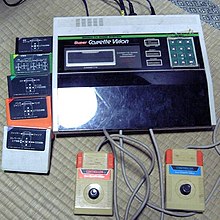
Launch
[edit | edit source]The Super Cassette Vision was released by Epoch in 1984 to replace the older 1981 Epoch Cassette Vision and the cost reduced 1983 Epoch Cassette Vision Jr.[1]
On launch the Super Cassette Vision sold well in Japan, as well as in France.[2]
The Super Cassette Vision Lady was launched in 1985 and marketed to women.[3][4][1] This was the first notable console to pursue this strategy, later followed by others such as the Casio Loopy.[5]
Technology
[edit | edit source]Compute
[edit | edit source]The Super Cassette Vision used an 8-bit NEC PD7801G CPU (Based on the Z80) clocked at 4 megahertz.[6]
The system had 128 bytes of RAM and four kilobytes of VRAM.[6]
Notable games
[edit | edit source]- Lupin III
- Dragon Ball: Dragon Daihikyō
- Miner 2049er
- Boulder Dash
- Doraemon Nobita's Time Machine the Great Adventure
- Mappy
- Pole Position II
Gallery
[edit | edit source]Super Cassette Vision
[edit | edit source]Motherboard
[edit | edit source]References
[edit | edit source]| Parts of this page are based on materials from: Wikipedia: the free encyclopedia. |
- ↑ a b "Japanese Company Made Consoles For Girls, And Also Cute Toys". Kotaku. Retrieved 24 October 2020.
- ↑ "Epoch Super Cassette Vision (1984 - late 1980s)". Museum of Obsolete Media. 8 March 2014. Retrieved 28 October 2020.
- ↑ "Super Lady Cassette Vision – The Video Game Kraken". Retrieved 27 November 2020.
- ↑ "The Most Unusual Video Game Consoles" (in en). PCMAG. https://www.pcmag.com/news/the-most-unusual-video-game-consoles. Retrieved 24 October 2020.
- ↑ Packwood, Lewis (15 July 2018). "In the Loopy: the story of Casio's crazy 90s console" (in en). Eurogamer. https://www.eurogamer.net/articles/2018-07-15-in-the-loopy-the-story-of-casios-crazy-90s-console. Retrieved 24 October 2020.
- ↑ a b "OLD-COMPUTERS.COM : The Museum". www.old-computers.com. Retrieved 29 October 2020.
History
[edit | edit source]The Video Challenger was a VHS based console released in Japan in 1987.[1] The Video Challenger was released in other countries under different brands.[2] The system was oriented around light gun games.[3]
Technology
[edit | edit source]
The Video Challenger uses a Hitachi 8-bit HD401010 processor clocked at four megahertz, with access to 32 bytes of RAM.[4]
Notable games
[edit | edit source]- After Burner II by Sega[5]
- Turtle Challenge - Teenage Mutant Ninja Turtles game.[5]
- Sky Wars[5]
- Thunder Storm by Data East[5]
- Road Blaster by Data East[5]
- Space Challenge[5]
- Godzilla Challenger 1[5]
- Godzilla Challenger 2[5]
External Resources
[edit | edit source]- Video Game Kraken - Video Challenger page with photo and marketing information.
- Video Game Console Library - Video Challenger page with model and spec info.
References
[edit | edit source]| Parts of this page are based on materials from: Wikipedia: the free encyclopedia. |
- ↑ "Video Challenger Road Blaster (Japan)". 1 January 1987. Retrieved 29 October 2020.
- ↑ "Video Challenger by Select Merchandise – The Video Game Kraken". Retrieved 27 November 2020.
- ↑ "Video Challenger • Takara • 1987 : RAM OK ROM OK". Retrieved 31 October 2020.
- ↑ "Home Page". Video Game Console Library. Retrieved 4 November 2020.
- ↑ a b c d e f g h "Video Challenger". Wikipedia. 19 January 2021. Retrieved 13 April 2021.
Introduction
[edit | edit source]The Vidéoway was an experimental interactive video service that found a strong niche in 1990's Quebec. Due to it's unusual background coming from a telecom company rather then a computer or gaming company, the Vidéoway service was an early console that exclusively played downloaded games on a subscription model. Furthermore, true to its Quebec heritage, Vidéoway is one of the few significant gaming consoles to have French as a primary language, with English as a secondary language, rather than being English or Japanese first like most other consoles.
History
[edit | edit source]Development
[edit | edit source]
The Vidéoway system cost Vidéotron $40 million to develop.[1][2] Notably, Montreal had yet to develop it's now massive game industry when the Vidéoway was developed, making this console a pioneer of sorts for the industry in that area.[3]
Launch
[edit | edit source]
Even the Japanese Are Jealous—Videoway Slogan, 1993 New York Times Article[2]
Vidéotron launched the Videoway in 1989.[4] While the service offered a number of features such as interactive camera angles, video games were one of it's most popular features.[2] By 1992 Vidéoway had a competitive leaderboard for certain games, with ranks assigned to players and with high ranking players invited to some TV shows to compete for prizes.[3]
By 1993 the Vidéoway was profitable,[1] costing a fee equivalent to $6.50 USD a month to use the service with 160,000 households subscribing to the service.[2] In November 1993 it was announced a plan to expand the Vidéoway service from Montreal to Dayton, Ohio.[5][6] To build a market in Dayton, the service would initially be free.[7] However by 1994 Dayton was not listed as an area where Vidéoway was sold,[8] making the fate of the Dayton expansion unclear.
By 1994 the service had 220,000 subscribers in the Montreal Market alone[1], with 330,000 customers globally, having expanded to the UK.[8] In 1994 the video games offered on the system were considered it's main selling point, rather then the other interactive television features supported by the platform.[1]
By 1995 the number of Vidéoway subscribers in Quebec remained steady at 222,000 with a monthly price of $8.95 Canadian dollars.[9]
Legacy
[edit | edit source]
The Vidéoway service was discontinued in 2000,[10] and shut down in 2006, with the original games having been lost to time.[3] In the 2015 Temporel, Inc was unofficially remade based on using a VHS recording of a play-through.[3]
Despite being poorly documented, this service is notable for being one of the best performing Canadian platforms in console gaming, as well as an early adoption of the game streaming model later seen decades later in the cloud gaming market of the 2010's on.
Technology
[edit | edit source]
The Vidéoway has an 8-bit Motorola MC68A09EP clocked at 1.5 megahertz as a local processor.[10][11] The Vidéoway has 8 Kibibytes of static RAM and 256 Kibibytes of dynamic video RAM.[11] The system also has a 16 Kibibyte mask ROM.[11]
System RAM temporarily stored downloaded games for the Vidéoway.[3]
In 1994 a partnership was made with the massive American technology corporation IBM (International Business Machines) to improve the Vidéoway.[8]
Notable games
[edit | edit source]Around forty games were available on the Vidéoway.[4] Notably, many games on the Vidéoway are said to have appealed to casual gamers,[2] an underserved market at the time.
- Temporel Inc.[4] - An adventure game exclusive to the Vidéoway[3] during the life of the system.
- Jeopardy[2]
- Blackjack[2]
- Chess[2]
- Q-Bert[4][3]
- Mordicus[4]
- Burger Time[3] / Hamburger[4]
- Styx[4]
- Mr. Chin[4][3]
- Le fou du Roi[4]
- Crocomaths[4]
Branding
[edit | edit source]Throughout the long life of the system, Vidéotron updated its brand identity twice. Most game platforms see their parent organization update their branding only once, if they do so at all, in their time on the market, making this somewhat unusual.
-
The Vidéotron logo used from 1980 to 2001. This was the logo used by the company during the hayday of the service.
-
The Vidéotron logo used from 2001 to 2004. This was the logo used by the company while the service was being sunset.
-
The Vidéotron logo from 2004 to 2009. This was the logo used by the company during the final years of the service.
References
[edit | edit source]- ↑ a b c d "Videotron Videoway". The Indianapolis Star. 11 April 1994. p. 31. Retrieved 7 November 2020.
- ↑ a b c d e f g h Tierney, John (20 June 1993). "Will Tomorrow's TV Viewers Sit by the Set, or Ride a Data Highway? (Published 1993)". The New York Times. https://www.nytimes.com/1993/06/20/technology/will-tomorrows-tv-viewers-sit-by-the-set-or-ride-a-data-highway.html.
- ↑ a b c d e f g h i "Temporel, inc. and the Videoway system – Hardcore Gaming 101". Retrieved 31 October 2020.
- ↑ a b c d e f g h i j "Videoway – Montreal Video Game Museum". Retrieved 31 October 2020.
- ↑ "GROUPE VIDEOTRON LTEE TO INSTALL VIDEOWAY". Computer Business Review. 2 November 1993. Retrieved 7 November 2020.
- ↑ "Financial Briefs". Variety. 1 November 1993. Retrieved 7 November 2020.
- ↑ "NETWORKING". WWD. 16 August 1994. Retrieved 7 November 2020.
- ↑ a b c "COMPANY NEWS; Videotron and I.B.M. to Explore Interactive Technology (Published 1994)". The New York Times. 12 March 1994. https://www.nytimes.com/1994/03/12/business/company-news-videotron-and-ibm-to-explore-interactive-technology.html.
- ↑ Sandomir, Richard (17 April 1995). "THE MEDIA BUSINESS; California Viewers Getting the Chance to Direct Their Sportscasts (Published 1995)". The New York Times. https://www.nytimes.com/1995/04/17/business/media-business-california-viewers-getting-chance-direct-their-sportscasts.html.
- ↑ a b "Videoway device". CodeWalrus. Retrieved 1 February 2021.
- ↑ a b c "The Vidéoway emulation thread - Forums". web.archive.org. 17 January 2018. Retrieved 1 February 2021.
-
The View-Master Interactive Vision with Controller
History
[edit | edit source]Development
[edit | edit source]
The View-Master Ideal Group was the result of serval mergers of the View-Master company.[1]
Launch
[edit | edit source]The View-Master Interactive Vision was released in 1988 by the View-Master Ideal Group at a cost of $130.[2][3][4]
Legacy
[edit | edit source]The View-Master Ideal Group was acquired in 1989.[1]
Technology
[edit | edit source]
The system was primarily used to generate graphic overlays on VHS tapes, creating interactive experiences where players could determine the outcome of scenes.[2][5] The VHS tapes used by the system contains the software to run the system.[6]
Compute
[edit | edit source]The View-Master uses a TMS9128NL chip for video.[7]
Notable games
[edit | edit source]All the games for the View-Master Interactive Vision are either based on Sesame Street, The Muppets, or Disney.
- Muppet Madness
- Muppet Studios Presents: Your the Director
- Sesame Street: Let’s Learn to Play Together
- Sesame Street: Let’s Play School
- Sesame Street: Magic on Sesame Street
- Sesame Street: Oscar’s Letter Party
Gallery
[edit | edit source]Console
[edit | edit source]Controller
[edit | edit source]Internals
[edit | edit source]References
[edit | edit source]| Parts of this page are based on materials from: Wikipedia: the free encyclopedia. |
- ↑ a b "60 Years of View-Master History from Sawyers to Mattel". www.viewmaster.co.uk. Retrieved 29 October 2020.
- ↑ a b "[View-Master Interactive Vision] Muppet Madness". 1 January 1988. Retrieved 26 October 2020.
- ↑ "What is the View-Master Interactive Vision? YoExpert Q&A". classic-video-games.yoexpert.com. Retrieved 29 October 2020.
- ↑ Personal Computing. Personal Computing Magazine. Retrieved 3 December 2020.
- ↑ "Only In The 80's Would They Put Video Games On A VHS Tape" (in en-us). Kotaku. https://kotaku.com/only-in-the-80s-would-they-put-video-games-on-a-vhs-tap-5786220. Retrieved 26 October 2020.
- ↑ Paul, Franzen (1 October 2008). "Dear Readers: View-Master Interactive Vision". GameCola. Retrieved 26 October 2020.
- ↑ "The motherboard of a View-Master Interactive Vision, a sorta gaming, edutainment console from 1988. This is the flat view, and is shown with the RF shielding removed. The following is some chip data and information copied from the board:". 14 June 2014. Retrieved 29 October 2020.
-
The VTech Socrates with keyboard and controllers.
History
[edit | edit source]
The VTech Socrates was preceded by the VTech CreatiVision.
The VTech Socrates was released in 1988 at a cost of $130.[1] Marketing for the system emphasized it's educational value.[2] The system featured a robot mascot named Socrates, who borrowed its name from the ancient Greek philosopher Socrates.[3]
Technology
[edit | edit source]Compute
[edit | edit source]The VTech Socrates uses either a 8-bit TMP Z84C00AP-6 CPU, which is based on the Z80 and is clocked at 3.58 MHz[4] or a similar Zilog Z84C0004PSC.[5]
The VTech Socrates had 64 kilobytes of RAM.[4]
Input
[edit | edit source]The system came with a wireless keyboard, and an optional touchpad and optional wireless mouse and mouse pad were made available.[1]
A voice cartridge add on was available for the system.[1]
Notable games
[edit | edit source]- Amazing Mazes - Maze game[6]
- Around the World - World geography software[6]
- CAD Professor - Uses the mouse add on.[6]
- Facts 'N Fractions - Math software[6]
- Game Wizard - Logic[6]
- Hodge Podge - Word games[6]
- Memory Mania - Memory game[6]
- Numbers, Shapes, and Letters - Uses the touchpad add on.[6]
- State to State - United States geography[6]
Gallery
[edit | edit source]Console
[edit | edit source]Wireless Inferred Controller
[edit | edit source]Internals
[edit | edit source]References
[edit | edit source]| Parts of this page are based on materials from: Wikipedia: the free encyclopedia. |
- ↑ a b c "ARCHIVE.ORG Console Library: Socrates : Free Software : Free Download, Borrow and Streaming : Internet Archive". archive.org. Retrieved 28 October 2020.
- ↑ Dines, Gail; Humez, Jean M. Gender, Race and Class in Media: A Text-Reader. SAGE Publications. ISBN 978-0-8039-5163-1. Retrieved 3 December 2020.
- ↑ "ARCHIVE.ORG Console Library: Socrates : Free Software : Free Download, Borrow and Streaming : Internet Archive" (in en). archive.org. https://archive.org/details/socrates_library.
- ↑ a b "68k Mentat - VTech Socrates". new.68kmentat.com. Retrieved 28 October 2020.
- ↑ "The motherboard of the Socrates, an educational entertainment ("edutainment") video game console released in 1988 by VTech. Powered by a Zilog Z80 processor, the board has two expansions for a voice cartridge and game cartridge. The system is comparatively weak, due to being designed to run off 6 D batteries". 18 November 2015. Retrieved 28 October 2020.
- ↑ a b c d e f g h i "VTech Socrates". Wikipedia. 17 February 2021. Retrieved 28 April 2021.
History
[edit | edit source]
The Daewoo Zemmix was a line of console versions of the MSX computer platform released in South Korea from 1985 to 1991.[1][2]
Launch
[edit | edit source]The MSX Daewoo Zemmix CPC-50 was released in Korea on December 10th of 1985.[3]
The MSX Daewoo Zemmix V CPC-51 was released in Korea in December of 1987.[3]
The MSX2 Daewoo Zemmix Super V CPC-61 was released in Korea in 1990.[3]
The MSX2+ Daewoo Zemmix Turbo CPG-120 was released in Korea in October of 1991.[3]
Legacy
[edit | edit source]A fanmade and unofficial Zemmix Neo was launched in 2013.[4]
Technology
[edit | edit source]An add on was made to allow Famicom games to be played on the Zemmix.[5]
Notable games
[edit | edit source]Zemmix game compatibility depends on the particular MSX standard used by a given Zemmix console.
External Resources
[edit | edit source]- Game Medium - Zemmix page.
- Video Game Geek - Zemmix CPC 50 page.
- Hardcore Gaming 101 - History of Korean Gaming.
References
[edit | edit source]- ↑ "Home Page". Video Game Console Library. Retrieved 31 October 2020.
- ↑ "Daewoo Zemmix - Ultimate Console Database". ultimateconsoledatabase.com. Retrieved 8 November 2020.
- ↑ a b c d "Hardcore Gaming 101: A History of Korean Gaming". www.hardcoregaming101.net. Retrieved 8 November 2020.
- ↑ "Diehard Fans in Korea Made Their Own MSX Console. It's Pretty". Kotaku. Retrieved 13 November 2020.
- ↑ H, Jimmy (31 March 2015). "Obscure Video Game Systems: The Daewoo Zemmix". Obscure Video Game Systems. Retrieved 13 November 2020.
